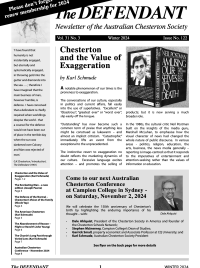A significant collection of Chesterton’s writings on the family has been assembled by this year’s keynote speaker at the Australian Chesterton Conference, Dale Ahlquist. Nicole Yap, a writer and designer and assistant to the editor of News Weekly, Peter Kelleher, has written this review of The Story of the Family (Ignatius Press, 2022), which is republished by the kind permission of both Nicole and Peter.
Defending the normal

What is the one institution that the state, try as it might, cannot replicate or replace? One which serves as the foundation of all other institutions? According to G.K. Chesterton, it is the family – the crazy, messy, loving, divine relationship between mother, father and child.
Dale Ahlquist, president of America’s Chesterton Society, has compiled Chesterton’s best quotes and essays on the topic, taking readers on a journey through the Story of the Family. Each chapter delves into the key elements of love, marriage, parenthood and the home.
It is a story told by what Chesterton describes as the “brave old bones of life” – the saucepan, the kettle, the coloured window, the vase of lilies, the umbrella stand, the hairbrush, the sink, the stove – all of which highlight the beauty, simplicity and delightful chaos of the home.

For decades, secular society has been subtly waging war on the family, in an attempt to centralise power and influence within the state or the “free” individual. As Ahlquist notes in his Introduction, this war begins when we attack marriage, then the marital act, then children, and in turn how we choose to raise them.
The first chapter starts with the “simple truth” that history began with a man, a woman and a child. Chesterton notes that this makes the family the oldest human institution in existence – one that cannot be abolished and will outlive all other institutions.
He clarifies, however, that the survival of the family is dependent upon an “internal sanctity” of love and dedication made perfect with the introduction of Christianity and the example of the Holy Family – Jesus, Mary and Joseph.
The alternative to the family that the world offers is the state. But the state, with too many of its legalities, bureaucracies and vested interests to go around, cannot replace parents in their role of rearing children and whole generations. Despite the world’s attempts, Chesterton affirms that “no negative reaction against [the family] comes anywhere near to having a positive substitute for it”.
Chapters two and three explore the first chronological steps of family life – love, romance and marriage – which are beautifully depicted in the concluding words of Chesterton’s letter to his then-fiancée Frances Blogg: “Here ends my previous existence. Take it: it led me to you.”
Exalting lust, forbidding fertility
He writes that what threatens a relationship built on sincere love, purpose and commitment is the “great heresy” of sexual immorality, one which “exalts lust and forbids fertility”. Chesterton’s observations were prophecies – the Sexual
Revolution of the 20th century paved the way for the many modern attacks against the family, including pornography, homosexuality, premarital sex, contraception and abortion.
Contemporary ideas have also presented marriage to be a mere contract in which divorce is an option, rather than marriage as “a duel to the death”, according to Chesterton. These ideas whisper that promiscuity and divorce make a man free when, in reality, freedom is found in the loyalty and honour of a wedding vow.
Then comes parenthood and the challenges of birth control, public education and the workplace, as examined in the last three chapters. To Chesterton, “the normal and real birth control is called self-control”. Couples ought to have an openness and zeal for new life and to view raising children as “remaking heaven and earth”.
Thus, Chesterton says that the duties of domestic life must be more highly regarded than those of public life. Parents’ blind reliance on public schools to educate their children, or a hyperfixation on work to the extent of neglect of family, is to the detriment of the order of the home. And, if the home is not in order, neither will be society.
Ahlquist aptly summarises the objective of this book and Chesterton’s broader work: to “defend the normal”, to point out what is obvious with fresh eyes so as to remind people why something was normal and obvious in the first place – because it works. The family as designed by God is a tried-and-tested model of love and life.
With Ahlquist’s careful curation and Chesterton’s prophetic wisdom, the Story of a Family is a wonderful read for all who wish to defend, promote and reserve the most basic unit of civilisation in an age that seeks to destroy it.
